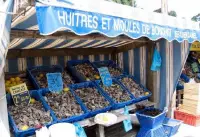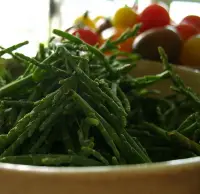 Earlier this year we spent a few days in Brittany with our two French grandchildren. During the trip, we visited Cancale, which lies along the coast to the east of Saint-Malo. It is a picturesque fishing village popular with visitors, many of whom are drawn by its reputation as the “oyster capital” of Brittany. On the sea front there are many stalls selling crustaceans of all types – all fresh out of the sea. I’ve never seen so many oysters of so many different shapes, colours and sizes.
Earlier this year we spent a few days in Brittany with our two French grandchildren. During the trip, we visited Cancale, which lies along the coast to the east of Saint-Malo. It is a picturesque fishing village popular with visitors, many of whom are drawn by its reputation as the “oyster capital” of Brittany. On the sea front there are many stalls selling crustaceans of all types – all fresh out of the sea. I’ve never seen so many oysters of so many different shapes, colours and sizes.
While we were there, we went into a shop owned by one of life’s “characters”! Everything we looked at was ‘the best in the world’… “Ah, zat box of snail shells, ‘ee iz zee best in zee world!” (Actually the guy was speaking French, but I’m sure you get the gist!!)
Well, it seems to have worked because we walked out clutching a bag of ‘goodies’ and were about 100 euros lighter in our pockets! However, one of the things we came away with was a small packet of Court Bouillon Marin (marine fish stock – and that’s a very loose translation!). I used it once and it was truly excellent, it really does add all the flavours of the sea to the fish. According to the packet, all it contains is sea salt, seaweed and herbs, but I can promise you, it really is “zee best in zee world”.
If your French is good enough, you can order this Court Bouillon Marin from the family that makes it… http://www.lehomedys.com/saveur.php. It’s perfect for (as the name implies) a court bouillon, but also for mussels, fish soup, or any sort of fish or crustacean.
 So, tonight, we’re going to be eating halibut, cooked in Court Bouillon Marin, and I’m really looking forward to it. However, we also bought some samphire (one of the salicornia species, also known as glasswort or pickleweed). If you’re not familiar with samphire, it is a succulent, salt tolerant plant that grows in salt marshes, on beaches, and among mangroves. Salicornia species can generally tolerate immersion in salt water and it is highly edible, either cooked or raw. Due to its high salt content, it must be cooked without any salt added, in plenty of water. It has a hard stringy core, and after cooking, the edible flesh is pulled off from the core. This flesh, after cooking, resembles seaweed in color, and the flavor and texture are like young spinach stems or asparagus… truly worth looking forward to with a nice crisp Chablis!
So, tonight, we’re going to be eating halibut, cooked in Court Bouillon Marin, and I’m really looking forward to it. However, we also bought some samphire (one of the salicornia species, also known as glasswort or pickleweed). If you’re not familiar with samphire, it is a succulent, salt tolerant plant that grows in salt marshes, on beaches, and among mangroves. Salicornia species can generally tolerate immersion in salt water and it is highly edible, either cooked or raw. Due to its high salt content, it must be cooked without any salt added, in plenty of water. It has a hard stringy core, and after cooking, the edible flesh is pulled off from the core. This flesh, after cooking, resembles seaweed in color, and the flavor and texture are like young spinach stems or asparagus… truly worth looking forward to with a nice crisp Chablis!